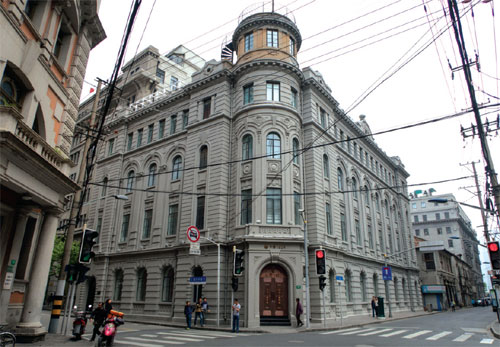|
|

The tenant of this protected historic building near the Bund painted most of its street-facing exterior gray before the local authorities caught up with him. [Gao Erqiang / China Daily] |
The tenant of a protected historical building in Shanghai caused a stir last month by painting its exterior a different color without gaining approval from the authorities.
The building, which was completed in 1914, was used by foreign banks until the late 1940s. In 1999, the Shanghai municipal government conferred on it protected status.
Some local residents subsequently uploaded photos of the project online showing how the color was quite different from the original stone faade.
The city's housing administration bureau, which is responsible for historical buildings such as this, responded by saying that the tenant had not been permitted to proceed with the renovation work.
It halted the project but found that the damage had already been done. Only a small part of the building's faade is now the original yellow color while most of the street-facing facade is gray.
The government is duty-bound to protect heritage buildings, the value of which is hard to calculate because of their rich history as public property in addition to their basic real-estate value.
In Jinan, Shandong province, local residents organize annual activities commemorating the city's former railway station, a masterpiece designed by a famous German architect in 1904. The station was torn down in 1992 to give way to a new one featuring glass walls.
Shanghai already serves as an example for other Chinese cities in terms of protecting historical buildings. The government conducted extensive research from the 1980s to 1990s on all of the old buildings in the city and classified them into different grades. Each grade affords a different level of protection.
As such, most of the city's old buildings are well-preserved and still function well after a century or more.
But the city still needs to draw lessons from the recent case involving the former bank, which could have been better supervised.
In fact, punishment should only be considered a last resort to deter wrongdoers. Although the bureau acted quickly once it had been alerted to the photos posted online, the damage cannot be undone. And if the authorities always rely on the public to inform it of transgressions after the fact, its job will be reduced from protecting property to dispensing fines.
Had local residents not spread the photos online, the repainting project would have been finished before the bureau noticed it. Obviously, the problem becomes even more problematic when it comes to internal renovations.
The bureau said the tenant submitted an application to repaint the wall beforehand but continued with the project after the bureau turned down the application.
According to the law, the tenant will be fined between 2 percent and 30 percent of the building's estimated value.
An effective way to deter wrongdoers would be to strengthen the implementation of the rules and make the punishments more severe. In some European countries, damaging historic buildings can result in charges being meted out under criminal law.
The government and media should also raise awareness of the need to protect such heritage sites.
China is modernizing at an incredible rate as the country's urbanization drive continues. Inevitably, it seems, many old buildings are being replaced by modern complexes and malls that look no different from one another.
As many old buildings are densely concentrated in parts of cities that used to rank as downtown areas, local governments would do better to classify urban areas into different grades according to their historical significance rather than focusing on individual buildings.
It is not just the buildings themselves, but also the communities that inhabit them or their environs that are integral parts of the city.
In Beijing, the whole urban area within the second ring road is defined as a "historical and cultural preservation area". The population is controlled, and the value of the historic buildings there is so high that the owners know it is more profitable to preserve them rather than build over them.
The authorities can provide more professional guidance and strict supervision to help the tenants or owners renovate and consolidate the buildings in an appropriate way. This form of cooperation between the government and public would be win-win.
liyang@chinadaily.com.cn
|